Embark on a visual journey into the heart of Edo, Japan, with our exclusive collection of Utagawa Kuniyoshi’s Japanese prints. These masterpieces, now available for free download, offer a unique window into this era’s rich cultural history and artistic brilliance.
My Encounter with Kuniyoshi’s Art
My fascination with Japanese culture was ignited at the “Kimono: Kyoto To Catwalk” exhibition at the V&A Museum. Amidst exquisite kimonos that whispered tales of ancient times, I discovered the dynamic and captivating Utagawa Kuniyoshi prints. A print featuring a warrior in an ornate kimono struck me with its intricate detail and vibrancy.
A Tribute to Utagawa Kuniyoshi
Utagawa Kuniyoshi, a pivotal member of the Utagawa school and a luminary of the 19th-century Japanese art scene, was celebrated for his ukiyo-e warrior prints, use of colour and remarkable talent.
His art transcended the depictions of the battles of legendary samurai heroes, extending to whimsical narratives and enchanting depictions of Japanese folklore, mythical animals, and even the supernatural.
Understanding Ukiyo-e: The Art of the Floating World
Ukiyo-e, representing the ephemeral “floating world” of the Edo period, was masterfully executed by Kuniyoshi. These vibrant woodblock prints captured the essence of daily life and culture in Japan, from kabuki actors and beautiful courtesans to sumo wrestlers and folklore.
Ukiyo-e was akin to Edo’s social media, widely popular and influential, even inspiring Western 19th century art movements like Art Nouveau and Impressionism.
Early Life and Artistic Beginnings
- Birth and Background: Utagawa Kuniyoshi was born in 1797 in Edo (present-day Tokyo). He was the son of a silk-dyer. His father’s business perhaps influenced his later rich use of color in his prints.
- Early Training: Young Kuniyoshi showed drawing talents at a young age and was apprenticed to the Utagawa school, one of the most prominent woodblock print schools of the time. He trained under Utagawa Toyokuni I, gaining a solid foundation in the art of ukiyo-e colour woodblock print.
- First Published Work: His first significant success came with the 1827 series “Tūszoku Suikoden Gōketsu Hyakuhachinin” (The 108 Heroes of the Popular Suikoden), which depicted scenes from a classical Chinese novel. This series marked his promising debut and established him as a talented artist in the competitive world of ukiyo-e.
Artistic Development and Major Themes
- Range of Kuniyoshi’s Work: Kuniyoshi’s work is characterized by diverse subjects. He is renowned for his depictions of the battles of legendary samurai heroes, historical narratives, and pictures of beautiful women. He also created landscapes, actor prints, and images of animals and mythical creatures.
- Kuniyoshi’s Warrior Prints: Kuniyoshi is particularly celebrated for his ukiyo-e warrior prints. He brought a new level of dynamism and dramatic intensity to the portrayal of samurai and heroes from Japanese folklore.
- Influence of Western Art: Kuniyoshi was among the Japanese artists who incorporated elements of Western art into their work. This included the use of perspective and shading, which added depth and realism to his prints.
- Portraits of Beautiful Women and Actor Prints: In addition to warriors, Kuniyoshi also excelled in creating actor prints and portraits of beautiful women such as Tokiwa Gozen. Reflecting Edo fashion and societal norms. His artistic talent in this area is noted for its elegance and attention to detail.
Legacy and Influence
- Role as an Independent Artist: Kuniyoshi’s innovative approach and unique style established him as a significant independent artist within the Utagawa school and the broader ukiyo-e genre.
- Impact on Later Generations: His work had a lasting influence on Japanese art and culture. Elements of his style can be seen in modern manga and anime. Additionally, his use of color and composition influenced later generations of artists in Japan and the West.
- Continued Relevance: Today, Kuniyoshi’s prints are celebrated for their artistic quality and historical value. They provide insight into the cultural and societal aspects of Edo-period Japan and continue to be appreciated by art enthusiasts worldwide.

Suikoden Series
Utagawa Kuniyoshi rose to prominence in Japanese art with his Heroes of the Suikoden series, introduced in the 1820s. These works vividly reimagined the 108 heroes from Chinese tales, showcasing Kuniyoshi’s dynamic style, intricate details, and rich colours. This series revitalized interest in these tales in Japan and influenced various art forms, including Kabuki and manga.
Kuniyoshi’s detailed portrayals of each character’s attire, weapons, and traits added narrative depth and cultural symbolism to his prints. The “Suikoden” series not only established Kuniyoshi as a master ukiyo-e artist but also popularized the warrior print genre in Japanese art, reflecting the cultural fascinations of the Edo period.
Utagawa Kuniyoshi & Utagawa Kunisada
In the realm of Utagawa Kuniyoshi’s art, it’s important to recognize his contemporary Utagawa Kunisada. Born in 1786, Kunisada was a leading figure in the Utagawa school, known for his vibrant depictions of Kabuki actors and Edo-period fashion.
While his themes differed from Kuniyoshi’s samurai and mythical subjects, Kunisada’s work offers a complementary perspective on 19th-century Japanese culture, making him a pivotal figure in the ukiyo-e tradition alongside Kuniyoshi.
How to Access The Utagawa Kuniyoshi Prints
Downloading these Japanese woodblock prints is simple and free. Click on the title of the Japanese woodcut print you want to download. A large copy of the image will open in a new tab on your device. If you right-click on that print, you can save it to your hard drive.
Japanese Woodblock Prints 1-10
The title of this print translates as “The Courtesan Usugumo of Tama-ya“. One of Utagawa Kuniyoshi’s later Japanese woodcut prints dated 1830.

2. Actor With Fan Under Cherry Blossom
Cherry blossoms are very symbolic in Japanese art and culture. It’s the blossom’s beauty and transience which associates them with mortality and graceful and readily acceptance of destiny and karma.
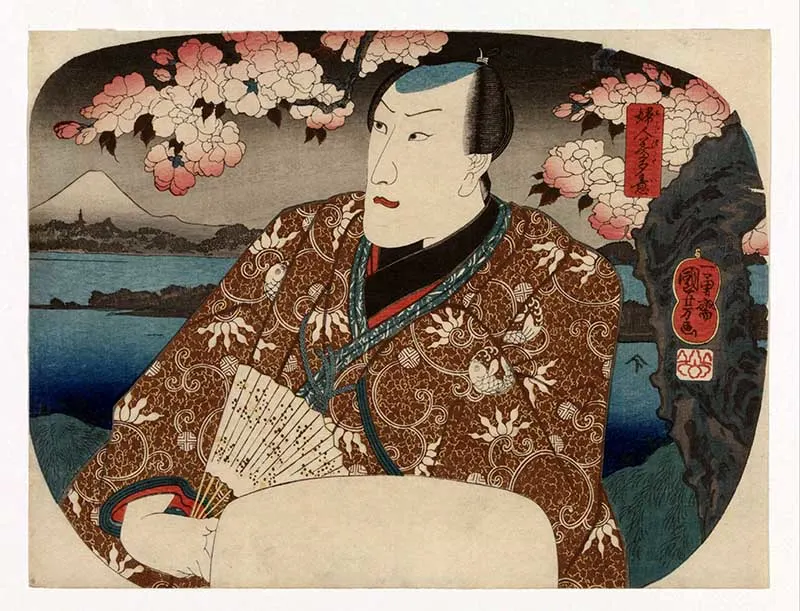
3. Bando Mitsugoro On The Stairs
Bando Mitsugoro was a Kabuki actor. Kabuki is a classical Japanese dance-drama.

4. Three Actors at A Folding Screen 1
The next three Japanese woodcut prints are part of the same series and displayed together as one.
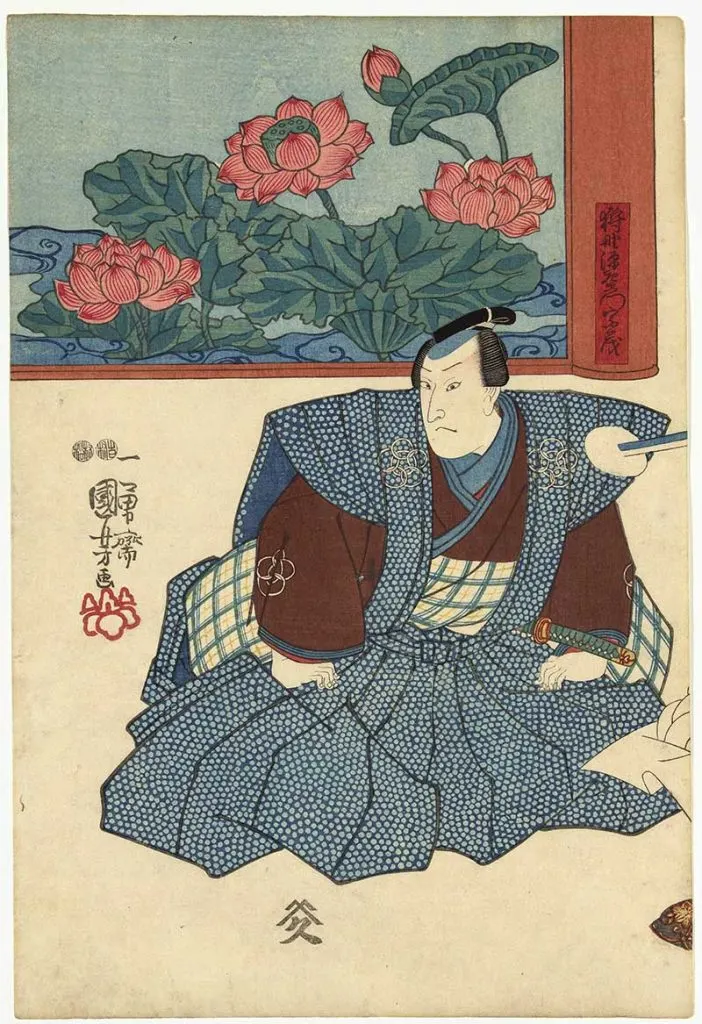
5. Three Actors at A Folding Screen 2

6. Three Actors at A Folding Screen 3

7. Ichikawa Danjūrō VII as a Peddler
Ichikawa Danjūrō VII (1791 – 1859) was a Japanese kabuki actor specialising in male hero (tachiyaku) roles, said to be the greatest of the 19th century.
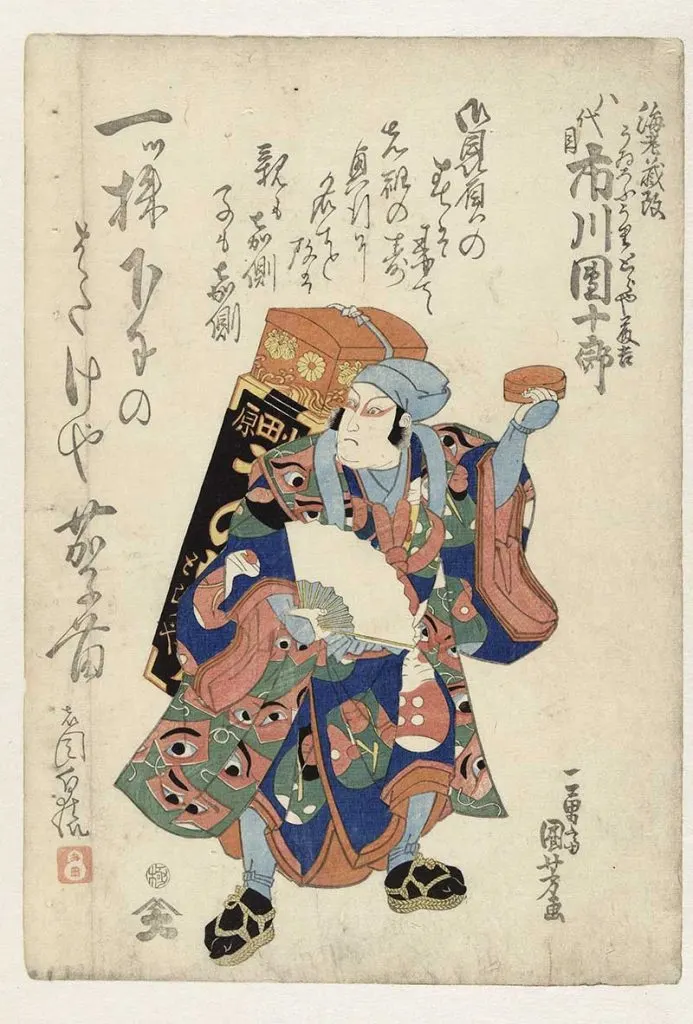
This is another woodblock print of a Japanese actor.

A traditional Japanese ukiyo-e style illustration of an actor Mimasu Gennosuke in the role of Naniwa Jirosaku.

10. Japanese Woodcut Print of Actor Nakamura Shikan II

Japanese Woodblock Prints 11-20
A scene from act 7 of the play Kanadehon Chūshingura.

The actor Tamaya Yoji.

Another Japanese actor.

14. Tamakatzura Tamatori Attacked by An Octopus
In Japanese culture, the Akkorokamui is a gigantic octopus-like monster from Ainu folklore, equivalent to the Nordic Kraken, which supposedly lurks in Funka Bay in Hokkaido. It is said that its enormous body can reach sizes of up to 33 meters (108 feet) in length.

15. Omatsu Attacking Akabori Mizuemon on a Boat with a Sword

The great 12th-century general Taira no Tomomori ties himself to an anchor to die by his hand and not from enemy action as defeat nears in the famous sea battle at Dan-no-Ura (1185). In “The Tale of Genji,” Lady Murasaki insists on making arrangements for her funeral rites as her death approaches.
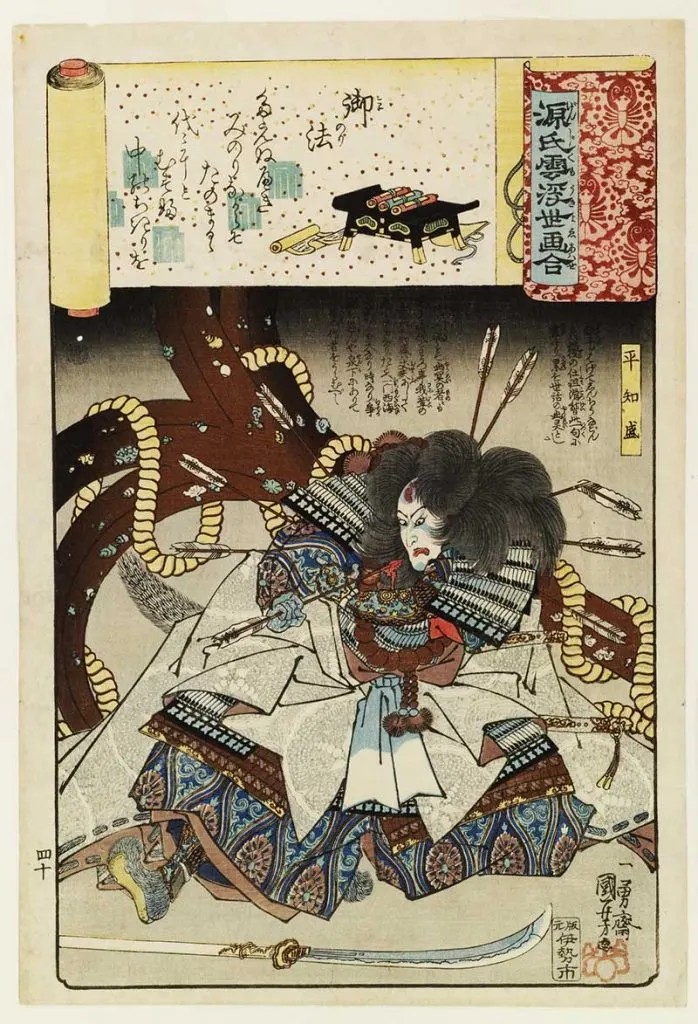
The Kabuki actor Bando Shuka I in a female role as Kosan (left) tucking some papers into her robe, and Ichikawa Danjuro VIII as Kingoro (right) seated in the background, from the kabuki play Kosan Kingoro, performed at the Nakamura theatre in the ninth month of Kaei 3 (1850).
This woodcut print is titled hare as there are a circle of hares (rabbits) in the top left corner.

An unidentified actor as Iwanaga Souren (left), with red make-up, sitting under a banner with a paulownia leaf crest, and an unknown actor as the courtesan Akoya (right) wearing a robe decorated with a Chinese lion.
You will notice a goat in the top left corner, hence the title of this print.

If you check there are some cats playing in the top left corner Japanese woodcut print.

20. Clearing Weather at Yamatoya
If you like this print of a woman in a kimono, you’ll probably also enjoy the Kimono art prints on the blog.

Utagawa-kuniyoshi Prints 21-30

22. Moso Hunting for Bamboo Shoots

23. Yoko Protecting his Father From a Tiger
You will find more tiger drawings and art here.

24. Mongaku Doing Penace at the Nachi Waterfall
Nachi Falls is one of the best-known waterfalls in Japan. With a drop of 133 meters (and 13 meters wide), it is the country’s tallest waterfall with a single uninterrupted drop.

25. Opening Shellfish at Fukagawa
Fukagawa is an area in Kōtō, Tokyo.

26. Woman in Boat on Sumida River
The Sumida River is a river that flows through central Tokyo, Japan. It branches from the Arakawa River at Iwabuchi and flows into Tokyo Bay. It’s from the Fashionable Women of the Suikoden series.
(This image was used for the DIY tea light lanterns craft)
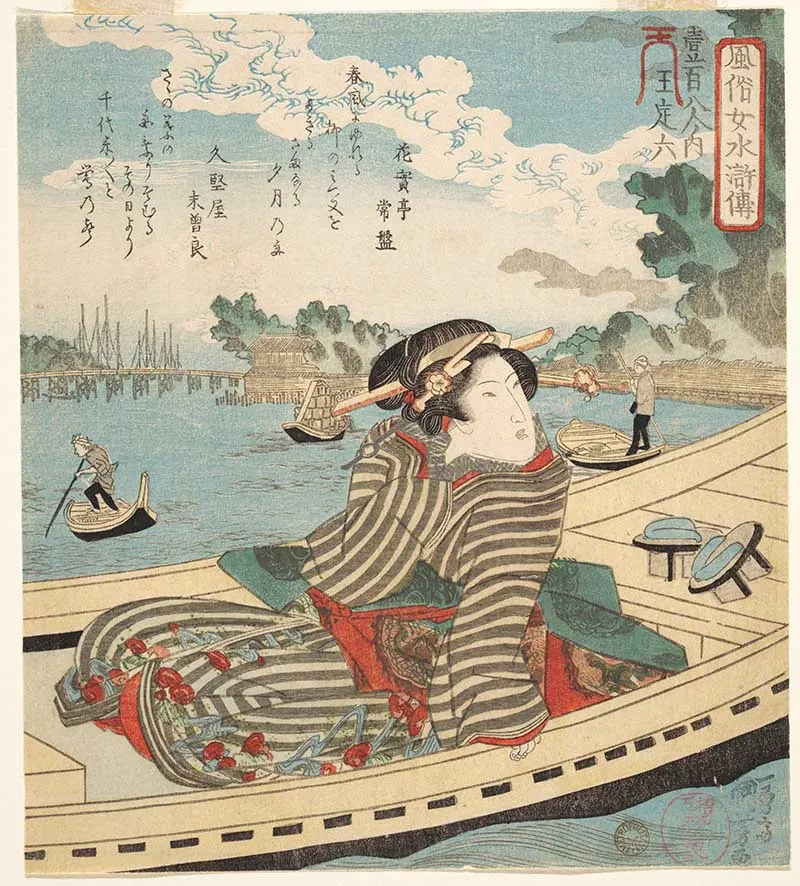
27. Hatsuhana Doing Penance Under the Tonosawa Waterfall

28. Tokiwa and Her Children Escaping in The Snow
“During the civil conflict of 1159, known as the Heiji Rebellion, the father of Yoshitsunewho was to grow into one of Japan’s most celebrated samurai heroes, was killed. In the wake of this tragedy, the boy’s mother escaped with him and his two brothers to the mountains during a snowstorm.
In this heartrending scene, the artist Kuniyoshi conveys the woman’s strength and maternal tenderness as she leans against the wind. The tiny shoes of the toddlers she protects are visible under her cloak. One of the boys would grow to become the founder of the Kamakura Shogunate and the other, Yoshitsune, would famously defend the honour of the Minamoto clan.”

29. Nichiren in Snow at Tsukahara, Sodo Province
A landscape painting with Nichiren, a Japanese Buddhist priest of the Kamakura period (1185–1333), who developed the teachings of Nichiren Buddhism.

30. Landscapes and Beauties- Feeling Like Reading the Next Volume.

“Recovering the Stolen Jewel from the Palace of the Dragon King” by Utagawa Kuniyoshi, featuring Ryugu Tamatori Hime.
Here, you will find more dragon pictures including a more detailed close up of this one.
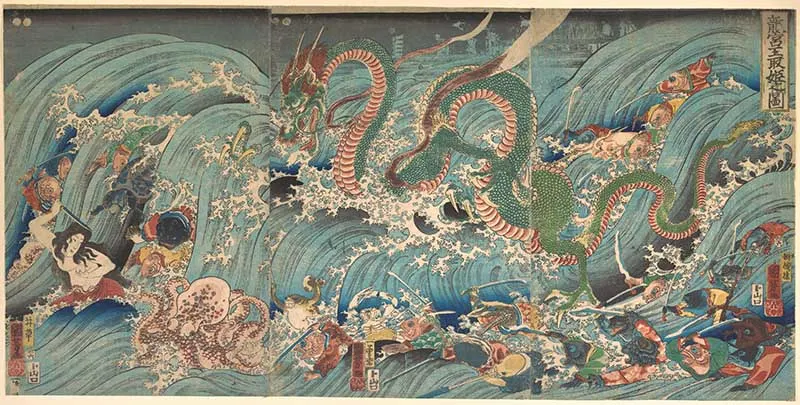
Oban Triptych Print Princess Takiyasha
The “Princess Takiyasha” triptych by Utagawa Kuniyoshi is a notable ukiyo-e work, famous for its dramatic portrayal of the legendary princess summoning a giant skeleton.
This three-panel print showcases Kuniyoshi’s mastery of composition and use of supernatural imagery, with Princess Takiyasha in one panel and the imposing skeleton dominating the others, menacingly reaching out towards warriors.
The piece is celebrated for its dynamic interaction, vivid colour use, and the way it blends folklore with artistic imagination, making it a significant work in Japanese art and cultural history.

Other Japanese Prints & Art
There are a couple of Utagawa Kuniyoshi prints in this collection of Japanese fish woodblocks.
If you are looking for other Japanese woodblock prints, check out the charming prints of Helen Hyde and the beautiful birds of Ohara Koson.
Check out the old Japanese art prints from the Shin-Bijutsukai, Watanabe Seitei and vintage Japanese patterns for Japanese patterns and design.
One of Utagawa’s woodcut prints is in this collection of elephant drawings, illustrations, and a few more with these owl drawings.
Suppose you enjoyed these Japanese woodcut prints of Utagawa Kuniyoshi. In that case, you should check out the fantastic old Japanese photos of Kusakabe Kimbei and the birds and flower paintings of Kono Bairei. And these easy cherry blossom drawing tutorials.



Mary Lee Smyth
Saturday 1st of January 2022
Happy 2022!
I have just found your site. Thank you so much for all the work you put into this wonderful space! I too have an affinity for maps. I also create hand cut wooden jigsaw puzzles. The combination of a vintage map image with my hand cut jigsaws are a very challenging match indeed! Here is my website if you would like to see what I do. https://smythpuzzles.ca/ Thank you again for your generosity. Wishing you and your loved ones peace, prosperity and good health in the future,
Sincerely, Mary Lee Smyth
claire
Monday 3rd of January 2022
Thank you, your jigsawslook great. Happy New Year!
Naush Samama
Saturday 31st of October 2020
Fascinating ! Thank you so much for joining us at Meraki Link Party. Much love Naush
claire
Saturday 31st of October 2020
Thank you, glad you enjoyed them.
Myrna
Saturday 31st of October 2020
They are really awesome. Thanks for sharing.
claire
Saturday 31st of October 2020
Thank you.
Kathy A
Friday 30th of October 2020
Thank you so much for finding these for us. I can think of lots of projects to use these for besides just framing them. I'd love to make several screens for my dollhouse people using them!
claire
Saturday 31st of October 2020
That sounds like a wonderful project. Yes they are great images to craft with.
Jeanne
Monday 26th of October 2020
I love Japanese woodcuts! The colors and patterns and the occasional ombre effects... Beautiful.
claire
Wednesday 28th of October 2020
Thank you, yes they are beautiful.